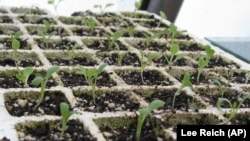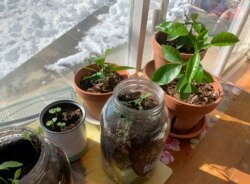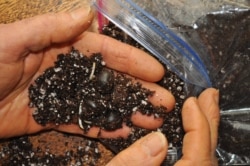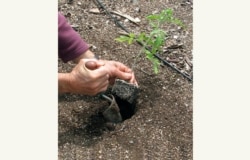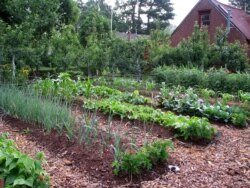From VOA Learning English, this is the Health & Lifestyle report.
If you have never grown your own transplants for your garden, perhaps this is the year to try.
First, what is a “transplant?” In gardening, transplant is the process of planting seeds inside and then moving the new growth, or sprout, outside.
Transplanting is easy and often costs less. You get to watch the new growth happen up close. It also lets you grow different kinds of fruits and vegetables that may have trouble growing from seed outside.
If you are new to this type of gardening, do not worry. A garden expert and writer for the Associated Press, Lee Reich, recently shared this advice.
Reich suggests starting with flowers or vegetables that are easy to grow from seed. Flowers such as zinnia, calendula, and cosmos are some of the easiest. Good choices for vegetables (depending on where you live) are lettuce, kale, cabbage, and the ever-popular tomato.
However, Reich and other experts warn that some vegetables should not be grown as transplants. Root vegetables -- such as carrots, beets, and parsnips -- do not transplant easily. The process can hurt the roots.
Vegetables such as corn, squash, cucumbers, melons, beans, and peas do not like to be transplanted. They can be transplanted with care, but you are better off planting them directly in the ground.
Container and soil
To get started with transplants, you will need a container and soil. The container should be between 5 to 10 centimeters deep. Some seeds need deeper dirt than others. You can use containers you may have around your house, like egg cartons.
Most important is that any container have one or more holes in the bottom. This is so some water can drain out.
Garden soil, even good garden soil, says Riech, will not work. It does not drain quickly enough in a container. Our expert suggests using a special mix called potting soil. Potting soil has additional material such as perlite, vermiculite, or sand to improve drainage.
Fill the containers with the potting soil and push it down – but not too much.
Plant the seeds
Then plant seeds, three or four in each container. Do this by making a small hole into the mix and put in the seed. Cover the seed with the potting soil and press gently again.
Place the containers in a pan, or any flat, open, and larger container that could hold some water. Put water into the pan until the water reaches halfway up the containers with the seeds. After a few hours, remove them from the water.
Germinate the seeds
Seeds need warmth to germinate. The amount of warmth needed is different from plant to plant. (Here, the word “germinate” means to cause a seed to begin to grow.) A good average temperature for just about all seeds is about 24° C.
If the temperature is colder or warmer, seeds will still germinate – just more slowly. Most seeds do not need light to germinate. So, you can place them anywhere in your home.
To keep moisture from drying up from the containers, cover them with clear glass or plastic.
The excitement begins!
Now for the exciting part -- waiting to see little, green sprouts! Remove all but the strongest sprout from each container. Just be careful not to hurt the roots of the sprout that remains.
Your goal now is to grow strong transplants that can survive a move to the outside garden. For this, you need lots of light and cooler temperatures. Even tomatoes, a summer vegetable, grow best as transplants with temperatures between 16 to 20° C.
Do not worry if you do not have perfect growing conditions.
A sunny, south-facing window works well, especially if the room is cool. Turn the plants daily so they grow in one direction toward the light.
You can also use a grow-light, either fluorescent or LED. Put the light close to the plants. Although these lights look bright, they do not compare with sun light. So, use both!
Be careful not to overwater or underwater. For strong growth, plants should be slightly underwatered.
In four to six weeks, most transplants should be two to three times the height of their containers. They should be strong and ready to be transplanted outside -- or almost ready.
Get them used to their future environment with a week of just being outside in the containers. Protect them from full sun, wind, and cold.
Now … they are ready to go into the garden!
And that’s the Health and Lifestyle report. I’m Anna Matteo.
And I’m Jill Robbins.
Lee Reich reported this story for The Associated Press. Anna Matteo adapted it for Learning English. Hai Do was the editor.
_______________________________________________________________
Words in This Story
garden -n. an area of ground where plants (such as flowers or vegetables) are grown
sprout -v. to send out new growth
carton -n. a light box or container usually made of cardboard or plastic
drain -v. to remove (liquid) from something by letting it flow away or out
potting soil -n. a mixture of dirt and other substances that people use when placing plants in pots
pan -n. a shallow open tray or container
germinate -v. to cause to sprout or develop



